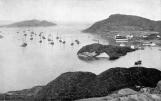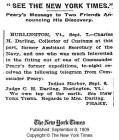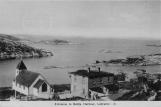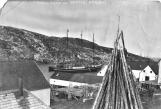

Battle Harbour National Historic Site
St. John's, Newfoundland and Labrador
5
Newspapermen on Battle Harbour wharf, LabradorSeptember 1909
Labrador
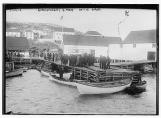 Credits:
Credits:Courtesy of Ted Hardy, St. John's NL
6
On Sept 5 1909 Commander Peary sent a message - 'We own the top of the world' - to The New York Times from the wireless station at Indian Harbour Labrador. The most sought after expeditionary prize of the time had been attained and the world was mesmerized by the messages wired from Labrador. Newspapers around the world were focused upon The New York Times, the paper with exclusive rights to Peary's story. Correspondents arrived in Sydney Nova Scotia with hopes of interviewing Robert Peary and his crew. When Peary did not arrive in Sydney by Thursday, the correspondents began looking for transport to Battle Harbour Labrador, the salt fish entrepreneurial station where Peary was repairing and provisioning his ship 'the Roosevelt'.
Battle Harbour, located some 425 miles up the Labrador coast, was accessible only by boat. Associated Press correspondents chartered 'the Douglas H. Thomas' and were the first to reach Battle Harbour, with other correspondents arriving several days later on 'the Tyrian'.
An article carried to Sydney on Sept 19 1909 on the Tyrian included the following description of the beginning of the press conference in Battle Harbour:
'In a dimly lighted loft, his head and shoulders silhouetted against a tiny window in front of which he was seated on a coil of rope, Commander Robert E. Peary, U.S.N., received his callers, and it was a heterogeneous set of guests who attended the reception, the first affair of its kind ever held in the fishing village of Battle Harbor. The reception room was the upper floor of the trading station kept by John T. Croucher.
It was approached by a flight of rough hewn board steps from the ground and a second climb up an almost perpendicular ladder to the loft. "Low bridge" was the cry as the guests began to arrive, led by the Commander and Mr. Croucher himself, who sat upon the left hand of his guest of honor during the reportorial "heckling."
A pale, cheerless Labrador sun weakly penetrated the gable window behind Peary. Tall and military in his bearing, the explorer was easily the commanding figure of the company gathered there. Dressed in a dark blue shirt of rough material, with trousers tucked in a pair of high top rubber boots that reached almost to his hips he looked for all the world like a Newfoundland fisherman. The feeble sunlight played about his tense, gaunt face and showed the lines and seams of his long life in the north. A sandy mustache and hair that had grown negligently in the arctic sought to give the lie to the precise expression of his mouth and searching look of his steel blue eyes.
To the Commander's right was jolly, good-natured Capt. Dickson of the Tyrian, who had piloted the correspondents through the stormy seas that lay between Sydney and the rugged Labrador coast. Malcolm, Capt. Dickson's twelve-year-old son, sat upon his knee, while around the big loft were ranged the guests. Nor were the guests confined to the fourth estate. Seated on the pile of fishing nets, studded with cork buoys, were intermingled correspondents, some of whom had come thousands of miles for this opportunity to hear the Commander's supplementary story; bewhiskered fishermen, tanned by the salt air of many northern Winters, blue-jackets from the Tyrian, spick and span, and sturdy sailormen who had sailed almost to the end of the world with the explorer.
When all were seated and introduced the interviewing began.' (excerpt from 'Winds Helped Most In Dash, Says Peary'. The New York Times. Sept. 20 1909).
